Olympic weightlifting
Olympic weightlifting
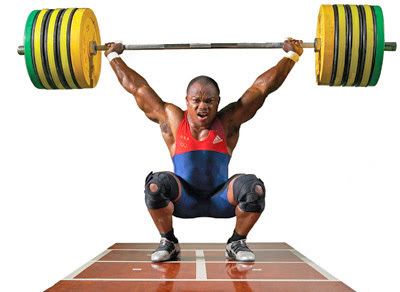
Olympic weightlifting, also called Olympic-style weightlifting, or weightlifting, is an athletic discipline in the modern Olympic programme in which the athlete attempts a maximum-weight single lift of a barbell loaded with weight plates.
The two competition lifts in order are the snatch and the clean and jerk. Each weightlifter receives three attempts in each, and the combined total of the highest two successful lifts determines the overall result within a bodyweight category. Bodyweight categories are different for women and men. A lifter who fails to complete at least one successful snatch and one successful clean and jerk also fails to total, and therefore receives an "incomplete" entry for the competition. The clean and press was once a competition lift, but was discontinued due to difficulties in judging proper form.

In comparison with other strength sports, which test limit strength (with or without lifting aids), Olympic weightlifting tests aspects of human ballistic limits (explosive strength) and are therefore executed faster—and with more mobility and a greater range of motion during their execution - than other lifts. Properly executed, the snatch and the clean and jerk are both dynamic and explosive while appearing graceful, especially when viewed from a recording at a slowed speed.
While there are relatively few competitive Olympic weightlifters (or more simply lifters), the lifts and their components are commonly used by elite athletes in other sports to train for both explosive and functional strength.
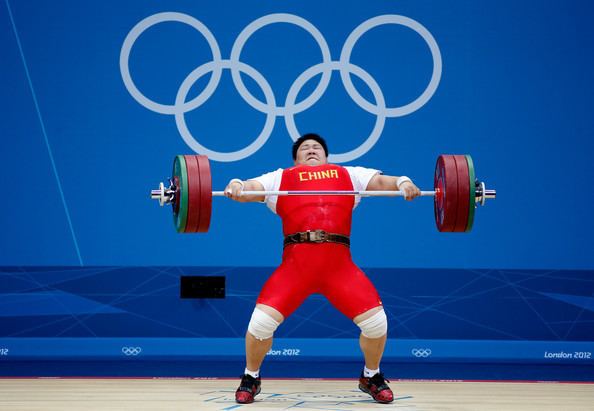
Competition
The sport is controlled by the International Weightlifting Federation (IWF). Based in Budapest, it was founded in 1905. Athletes compete in a division determined by their body mass. There are eight male divisions and seven female divisions since 1998.
Mens weight classes:
56 kg (123 lb)
62 kg (137 lb)
69 kg (152 lb)
77 kg (170 lb)
85 kg (187 lb)
94 kg (207 lb)
105 kg (231 lb)
and over 105 kg;
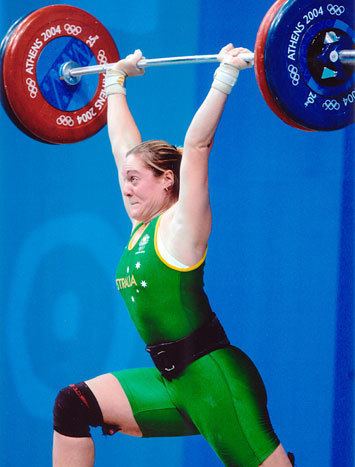
Womens weight classes:
48 kg (106 lb)
53 kg (117 lb)
58 kg (128 lb)
63 kg (139 lb)
69 kg (152 lb)
75 kg (165 lb)
and over 75 kg.
In each weight division, lifters compete in both the snatch and clean and jerk. Prizes are usually given for the heaviest weights lifted in each and in the overall—the maximum lifts of both combined. The order of the competition is up to the lifters—the competitor who chooses to attempt the lowest weight goes first. If they are unsuccessful at that weight, they have the option of reattempting at that weight or trying a heavier weight after any other competitors have made attempts at the previous weight or any other intermediate weights. The barbell is loaded incrementally and progresses to a heavier weight throughout the course of competition. Weights are set in 1 kilogram increments. When a tie occurs, the athlete with the lower bodyweight is declared the winner. If two athletes lift the same total weight and have the same bodyweight, the winner is the athlete who lifted the total weight first.
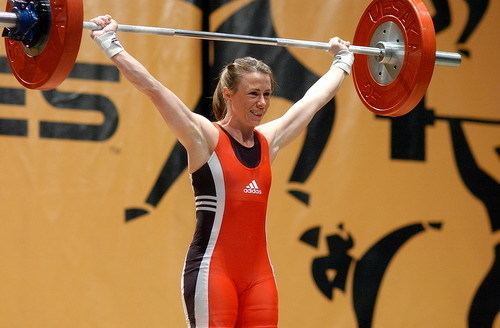
During competition, the snatch event takes place first, followed by a short intermission, and then the clean and jerk event. There are two side judges and one head referee who together provide a "successful" or "failed" result for each attempt based on their observation of the lift within the governing bodys rules and regulations. Two successes are required for any attempt to pass. Usually, the judges and referees results are registered via a lighting system with a white light indicating a "successful" lift and a red light indicating a "failed" lift. This is done for the benefit of all in attendance be they athlete, coach, administrator or audience. In addition, one or two technical officials may be present to advise during a ruling.
At local competitions, a "Best Lifter" title is commonly awarded. It is awarded to both the best mens and womens lifters. The award is based on a formula which employs the "Sinclair Coefficient", a coefficient derived and approved by the sports world governing body and which allows for differences in both gender and bodyweight. When the formula is applied to each lifters overall total and then grouped along with the other competitors and evaluated, it provides a numeric result which determines the competitions best overall mens and womens lifters. And while, usually, the winner of the heaviest weight class will have lifted the most overall weight during the course of a competition, a lifter in a lighter weight class may still have lifted more weight both relative to his or her own bodyweight and to the Sinclair coefficient formula thereby garnering the "Best Lifter" award.
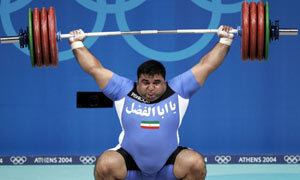
History
Competition among people concerning who can lift the heaviest weight has been recorded in diverse and ancient civilizations as early as the earliest known recordings of such human events, including those found in Egypt, China and in ancient Greece. Today, the modern sport of weightlifting traces its origins to the European competitions of the 19th century.
Fig : Greek commemorative coin featuring modern and ancient weightlifting (latter picture taken from Greek vase).
The first male world champion was crowned in 1891. Womens competition did not exist, and the weightlifters were not categorised by height or weight.
The first Olympic Games of 1896 included weightlifting in the Field event of the predecessor to todays Track and Field or Athletics event. During the 1900 Olympic Games, there was no weightlifting event. Weightlifting resumed as an event, again in Athletics, in 1904 but was omitted from the Games of 1908 and 1912. These were the last Games until after the First World War. In these early Games, a distinction was drawn between lifting with one hand only and lifting with two hands. The winner of the one hand competition in 1896 was Launceston Elliot, while the winner of the two hands event was Viggo Jensen of Denmark.
In 1920, weightlifting returned to the Olympics and, for the first time, as an event in its own right. At these Games, which took place in Antwerp, Belgium, fourteen nations competed. The competition lifts were the one hand snatch, the one hand clean and jerk and the two hands clean and jerk. At the next Olympic Games, in Paris, France, in 1924, the two hands press and the two hands snatch were added to the programme, making a total of five lifts.
In the Olympic Games after 1920, instead of requiring all competitors to compete against each other regardless of size, weight classes were introduced and, by the 1932 Olympic Games, weightlifting was divided into five weight divisions.
In 1928, the sport dropped the one hand exercises altogether leaving only the three remaining exercises: the clean and press, the snatch and the clean and jerk. By 1972, the clean and press was discontinued because athletes started to push with legs and bend backwards instead of strictly pressing the weight overhead, and this left the sole elements of what is todays modern Olympic weightlifting programme – the snatch and the clean and jerk. The snatch entails pulling with a very wide grip the barbell overhead without pressing out with the arms. It is a very precise lift that can be nullified by a lack of balance of the athlete. The clean and jerk is more forgiving using a narrower grip pull the bar to the shoulders and then using the strength of the legs push until arms reach full extension without a press out.
A competition for women was introduced at the 2000 Olympic Games in Sydney, Australia.
As early as 1987, there were official world championships awarded to women weightlifters such as Karyn Marshall and Judy Glenney.
In 2011 the International Weightlifting Federation ruled that athletes could wear a full-body "unitard" under the customary weightlifting uniform. Kulsoom Abdullah became the first woman to do so at the U.S. National Championships that year, and athletes are allowed to do so at the Olympics. IWF rules previously stated that an athletes knees and elbows must be visible so officials can determine if a lift is correctly executed.
Equipment
Olympic weightlifting uses a steel bar with rotating sleeves (also known as a barbell) which hold rubber-coated discs of different weights. The weight plates, typically referred to as "bumper plates" because of their rubber design, weigh between 0.5kg and 25kg. These plates are secured to the bar using collars on each sleeve that weigh exactly 2.5kg each. Lifters typically wear a one-piece, close-fitting leotard often called a singlet. The wearing of a t-shirt underneath the singlet is optional. A weightlifting belt of 120mm maximum width may also be worn to provide lower back support.

Perhaps the piece of equipment most peculiar to Olympic weightlifting are the shoes worn by lifters. Weightlifting shoes are typically designed with a raised heel of 0.5" to 1.5" and one or two metatarsal straps that tighten across the instep of the shoe. The shoes are designed for maximum stability while remaining flexible in the toebox. This allows the lifter to come up on their toes and catch the weight on the ball of their back foot during the "jerk" movement of their lift. The raised heel helps the lifter maintain an upright torso while catching the bar and also allows for a deeper squat under the bar.

World Weightlifting Championships
The World Weightlifting Championships is an event organised by International Weightlifting Federation (IWF). It has been held since 1891. In March 1891, competing against champions from Brussels, Hamburg, England, Vienna, Italy, and Berlin in a three-day event, Edward Lawrence Levy of England won the first World Weightlifting Championship. The event consisted mainly of repetition and alternate pressing, with 56 pounds (25 kg) or 84 pounds (38 kg) in each hand.
Athletes compete in a total of 15 weight categories (8 for men and 7 for women):
Men categories: 56 kg, 62 kg, 69 kg, 77 kg, 85 kg, 94 kg, 105 kg and +105 kg.
Women categories: 48 kg, 53 kg, 58 kg, 63 kg, 69 kg, 75 kg and +75 kg.

UnGuk Kim (DPR) Breaks Weightlifting World Record-below
.jpg)